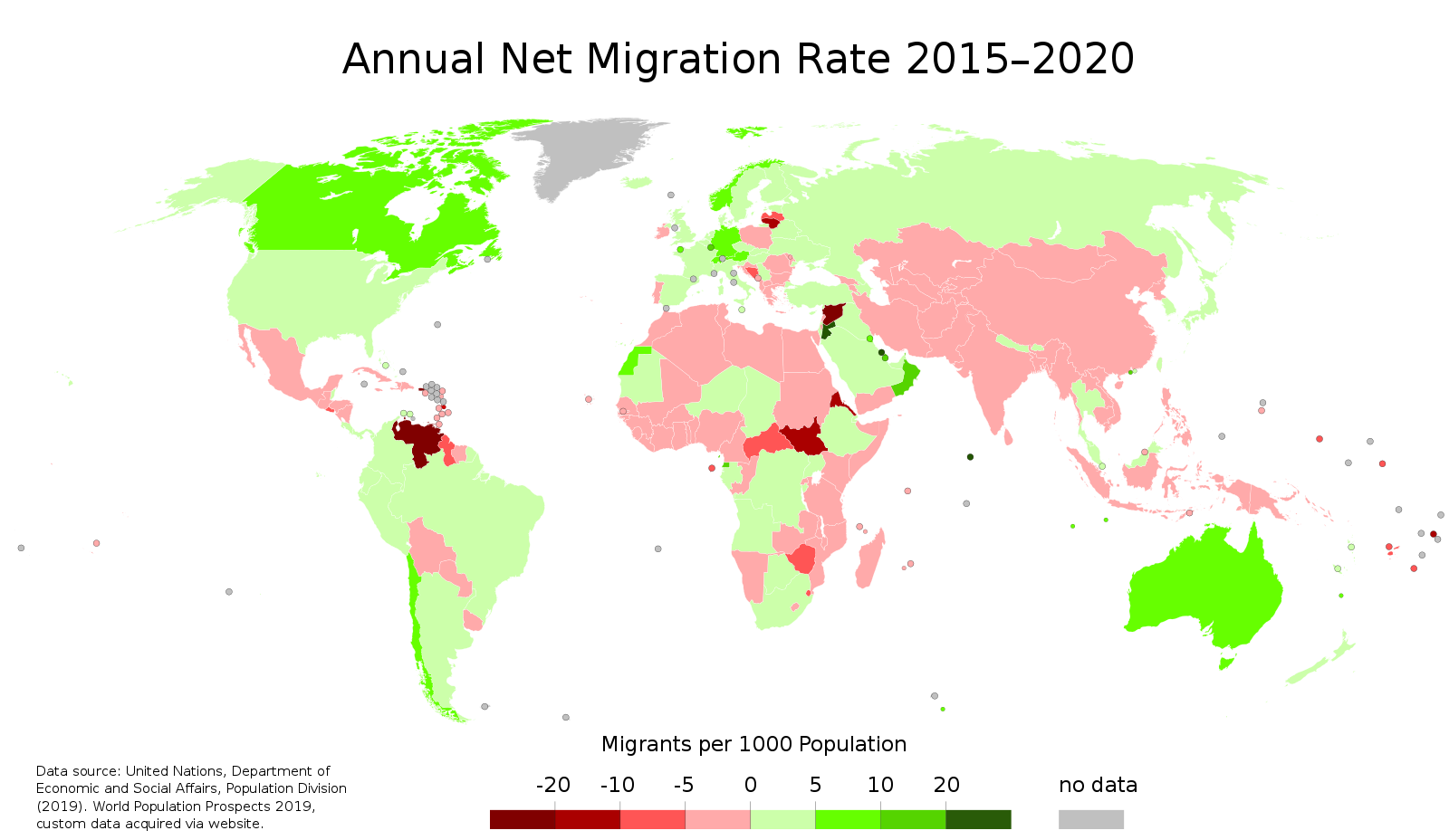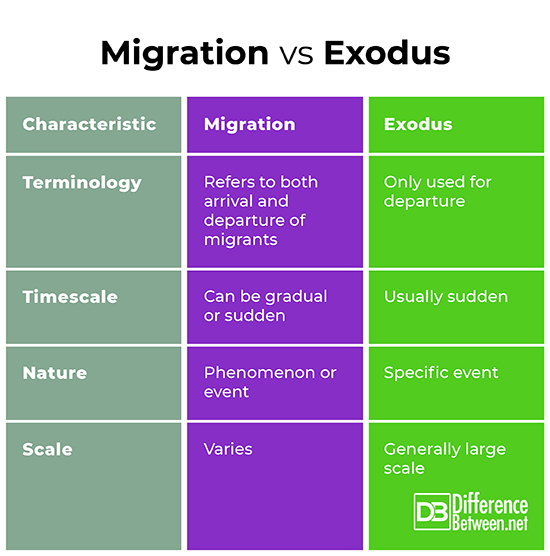Difference Between Migration and Exodus
What is Migration?
Migration means different things when used in ecology and in the context of human societies. In the context of ecology, migration means the movement of organisms from one region to another usually because of variations in temperature and food availability caused by the seasons. In human societies, it means any permanent change of residence by an individual or a group. Much of human history has been shaped by migrations of one sort or another.
Migration in ecology
In ecology, migration refers to the transient movement of individual animals or animal populations, usually due to seasonal variation in food availability and weather conditions. The most well-known migrant animals are probably migrant birds which are known to travel thousands of miles between their breeding grounds and non-breeding grounds.
Environmental driver of migration: the seasons
Earth’s seasons are caused by the planet’s axial tilt where the spin axis of Earth’s rotation is tilted with respect to the plane of its orbit around the sun. Because of this, different latitudes receive light of differing intensity which affects how much energy they receive. Areas where the sun’s light hits the surface at a low angle receive less energy and will have colder conditions, while areas where the sun’s light hits the surface at a higher angle will have warmer conditions. The seasons are determined by which hemisphere is tilted towards the sun. When the northern hemisphere is tilted towards the sun, it is northern summer. When the northern hemisphere is tilted away from the sun, it is northern winter. It is the same for the seasons in the southern hemisphere.
Evolutionary reasons for migration
Because of the changes in food abundance and weather conditions that prevail because of seasons, many animals have evolved the propensity to migrate. During the winter, animals including birds, Monarch butterflies, and certain mammals, in the northern hemisphere, will migrate south for the winter and return north with the arrival of summer. This seasonal migration seems to have been first noticed by humans as much as 20,000 years ago, based on Stone Age cave paintings. The earliest Western thinkers, at least, to study animal migration and try to come up with an explanation were the ancient Greek philosophers, such as Aristotle.
What is Human migration?
Humans move from the land of their birth to different lands for a variety of reasons. Some move voluntarily for economic and educational opportunities, while others are forced to migrate because of being enslaved or imprisoned. In other cases, people might become migrants as a result of needing to flee a war zone. Different types of migration can be defined as internal and international migration as well as voluntary or involuntary migration.
Internal migration
Internal migration refers to human migration within national boundaries. It is not uncommon for individuals or groups to move to different parts of the same country. Within the last century, the most common reason for internal migration has been migration from rural areas to urban areas. This has led to rapid urbanization since the end of World War II. This is especially true in developing countries.
International migration
International migration involves movement across international borders. In the past century, more people have moved permanently from their country of birth than ever before in history. Major reasons for migration have included seeking economic and educational opportunities. Many people have moved from the developing world to regions like western Europe and North America in search of a higher standard of living. Many have also traveled to other countries as international students. Other people have migrated as refugees from war zones or because of environmental deterioration.
One of the largest migrations in recent history has been the Great Atlantic Migration of Europeans to North America which began in the early 19th century as waves of Europeans moved from western Europe and then southern and eastern Europe to the North American continent.
Ancient examples of migration
Major migrations have happened throughout history. During the latter Paleolithic, Homo Sapiens, migrated out of Africa into Eurasia and eventually the Americas and Oceania. Another important migration is the movement of Indo-Europeans from the steppes of southern Russia and Ukraine into western Europe and India in the 3rd, 2nd, and 1st millennia BC. Still, another major migration was the movement of the ancestral Polynesians into the east Pacific, beginning around 3,000 years ago. Human migrations have significantly shaped global human history and culture.
What is Exodus?
The term Exodus usually refers to a single, rather sudden, departure from a region. The term originates from the Book of Exodus in the Hebrew Bible which recounts the Hebrew exodus from Egypt. According to the Book of Exodus, as well as Numbers and Deuteronomy, the Hebrews escaped from slavery in Egypt and moved out into the desert in large numbers.
According to the narrative, the ancient Hebrews were under the oppression of the ancient Egyptians and cried out to their national deity, Yahweh. Yahweh sent Moses to oppose Pharaoh and lead his people of Israel out of Egypt. Since the word exodus has been adopted as the English name for the book of the Bible recording this event, the term exodus has also been used for other similarly large-scale departures. Anytime a large population leaves an area in a relatively sudden or rapid fashion, it is often called an exodus or mass exodus. An example would be the recent Venezuelan migrant crisis in South America being referred to as an exodus.
Similarities between Migration and Exodus
Both terms refer to a large scale, permanent movement of people for a variety of reasons. Both types of population movement have also had a major influence on human history.
Differences between Migration and Exodus
Although there are similarities, there are also noticeable differences.
- Migration is used both to refer to the departure and arrival of migrants in a region, whereas the term exodus only refers to their departure.
- Migration can be gradual or sudden, whereas an exodus tends to be a sudden event, though how sudden depends on the timescale.
- Migration is a technical term used both in the study of human population movement and in ecology, whereas the term exodus is usually only used to refer to specific movements of human populations and does not appear to be a technical term.
- Migration is both an event and a phenomenon, whereas exodus refers to a specific event.
- Migrations can be small scale or large scale, whereas an exodus usually refers to large scale movements of people.
Migration vs. Exodus
Summary of Migration vs. Exodus
Migration is a term used in both ecology and in the study of human societies. In ecology, it typically refers to the seasonal migration of animal species to reach grounds which are better for feeding and breeding. In human societies, it refers to any movement of individuals or groups permanently from their place of origin to a new region. Reasons for migration can include to seek economic and educational opportunities or to escape war. Migration can also be involuntary in the case of enslavement or imprisonment. Migration can also be internal, from one region to another within the same national borders, or international. The term exodus refers to a sudden departure of a large group or population. It originates from the Book of Exodus in the Hebrew Bible where the ancient Hebrews depart Egypt to escape slavery. Migration and exodus are similar in that they both involve the permanent relocation of groups and individuals. On the other hand, there are distinct differences. Migration can be used to refer to both the arrival and departure of migrants. It can also be either sudden or gradual. Furthermore, it can vary in scale. In contrast, the term exodus refers only to the departure of a large group from a place or region and tends to be a relatively sudden event.
- Difference Between Environmental Performance Index and Development - November 24, 2023
- Difference Between Environmental Intervention and Development - November 8, 2023
- Difference Between Eco Efficiency and Eco Effectiveness - September 18, 2023
Search DifferenceBetween.net :
Leave a Response
References :
[0]Hirst, K. Kris. “Did Humans First Evolve in Africa?” https://www.thoughtco.com/out-of-africa-hypothesis-172030. Accessed 8 Oct. 2019
[1]“Migration.” United Nations, N.D., https://www.un.org/en/sections/issues-depth/migration/index.html.
[2]Nebel, Silke. “Animal Migration.” Nature Education Knowledge, vol. 3, no. 10, 2010, https://www.nature.com/scitable/knowledge/library/animal-migration-13259533/. Accessed 7 Oct. 2019.
[3]Plaut, W. Gunther. “The Book of Exodus.” https://www.myjewishlearning.com/article/the-book-of-exodus/. Accessed 8 Oct. 2019.
[4]Hirst, K. Kris. “Did Humans First Evolve in Africa?” https://www.thoughtco.com/out-of-africa-hypothesis-172030. Accessed 8 Oct. 2019
[5]Image credit: https://pixabay.com/de/vectors/exodus-bibel-moses-%C3%A4gypten-ccx-2153994/
[6]Image credit: https://commons.wikimedia.org/wiki/File:Annual_Net_Migration_Rate_2015%E2%80%932020.svg



